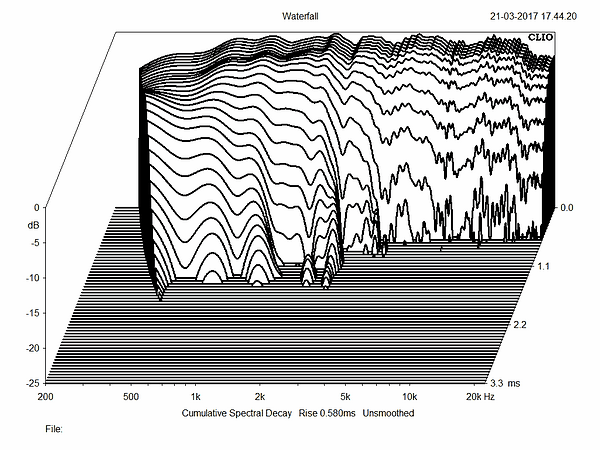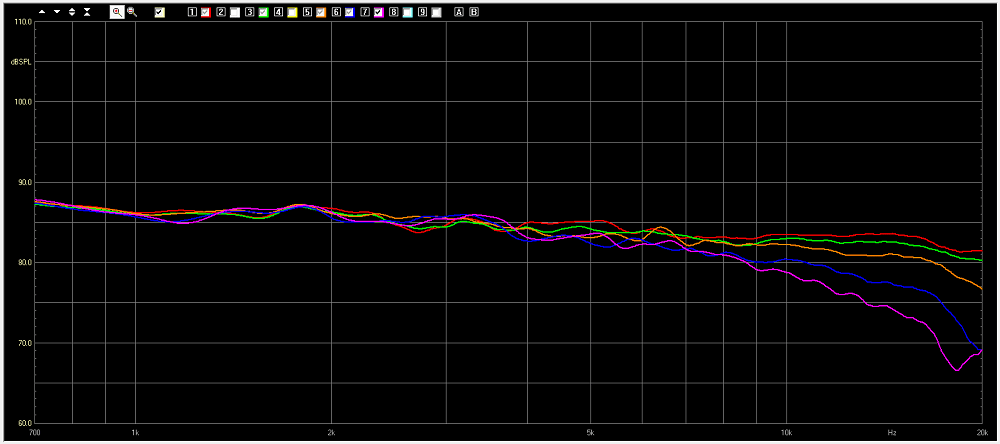Troels Gravesen seems to like stepped baffles and uses them a lot in his designs,
DIY Loudspeaker Projects Troels Gravesen
He is a prolific speaker designer and has designed speakers for Janzen and other companies.
Many of his designs incorporate a stepped baffle in order to time align the drivers.
Is this good or bad?
Doesn't time aligning the drivers on a stepped baffle mess up the off axis response? In other words, they are only time aligned face on and the more off axis you go, the less time aligned they are?
Isn't it best to compensate for the Z alignment of the drivers with the crossover on a flat baffle and therefore retain that time alignment off axis?
And then there are the diffraction problems that a stepped baffle introduces...
Thoughts?
DIY Loudspeaker Projects Troels Gravesen
He is a prolific speaker designer and has designed speakers for Janzen and other companies.
Many of his designs incorporate a stepped baffle in order to time align the drivers.
Is this good or bad?
Doesn't time aligning the drivers on a stepped baffle mess up the off axis response? In other words, they are only time aligned face on and the more off axis you go, the less time aligned they are?
Isn't it best to compensate for the Z alignment of the drivers with the crossover on a flat baffle and therefore retain that time alignment off axis?
And then there are the diffraction problems that a stepped baffle introduces...
Thoughts?
Attachments
It works the opposite. Imagine you draw a line through the acoustic centers. In a time-aligned, stepped baffle system, no matter the angle, that line is straight, vertical.
If you used DSP to time align a pair of drivers in a flat baffle, you'd only have a straight line in front and behind. to the sides, the time alignment would no longer hold.
To be complete though, I think his designs use a combination of stepped baffle and crossover alignment. As far as I know, most of his stepped baffle designs are not also time coincident.
Maybe some one can correct me, I'm too tired to do the research.
If you used DSP to time align a pair of drivers in a flat baffle, you'd only have a straight line in front and behind. to the sides, the time alignment would no longer hold.
To be complete though, I think his designs use a combination of stepped baffle and crossover alignment. As far as I know, most of his stepped baffle designs are not also time coincident.
Maybe some one can correct me, I'm too tired to do the research.
I think Dave is thinking of horizontally off-set driver's with horizontal axial differences.
Diffraction can be a problem, but that's true for a normal baffle as well - it's really all about the end-result. ..and yes, you can get differences in the vertical axis.
Diffraction can be a problem, but that's true for a normal baffle as well - it's really all about the end-result. ..and yes, you can get differences in the vertical axis.
Doesn't time aligning the drivers on a stepped baffle mess up the off axis response? In other words, they are only time aligned face on and the more off axis you go, the less time aligned they are?
Isn't it best to compensate for the Z alignment of the drivers with the crossover on a flat baffle and therefore retain that time alignment off axis?
Correct. Basically common Z-position of radiators' mouth and compensation of radiators' depth with delays by XO is better approach for off-axis timing. But that applies usually to horizontal plane only with multi-way so mechanical offset is not that terrible with quite flat radiators. Simplifies passive XO.
Unless you keep your head in a jig centred directly between the speakers and they are perfectly aligned, I don't think it makes any difference or is an improvement.
Move you head 10mm and that is far more than the baffle step.
Move you head 10mm and that is far more than the baffle step.
Troels Gravesen seems to like stepped baffles and uses them a lot in his designs...Is this good or bad? Thoughts?
It is his private decision for the reasons probably mentioned many times.
When you are a novice DIYer, you can't do much about it, either build as is or don't.
I could not do that for 3 reasons. It is ugly looking, produces diffraction effects and prevents me from building a higher order tweeter HP for protection and phase alignment purposes.
I have built his SEAS Classic 3-Ways, and they are musically communicative, easy to drive and very easy to listen to. The stepped baffles make sense to me, and - as has been mentioned above - should ideally put the acoustic radiating centres of the mid and tweeter on the same vertical axis (you are sure your head is at the right height, of course?).
On the other hand, I don't like the aesthetics of the stepped baffle, and, like Lojzek, find the thought of diffraction effects in the vertical axis from the step subliminally distracting. I'm at an advanced stage right now of building Troels' MUN-17, and find this design a lot more intuitively appealing (if also a lot more expensive!).
Alex
On the other hand, I don't like the aesthetics of the stepped baffle, and, like Lojzek, find the thought of diffraction effects in the vertical axis from the step subliminally distracting. I'm at an advanced stage right now of building Troels' MUN-17, and find this design a lot more intuitively appealing (if also a lot more expensive!).
Alex
So, the title of the thread could also mean something like "... stepped baffles, the good, bad and the ugly"? --->>> YouTube... I don't like the aesthetics of the stepped baffle...
It would hold, only the horizontal physical plane has been tilted. If you stay on this plane, no problem.If you used DSP to time align a pair of drivers in a flat baffle, you'd only have a straight line in front and behind. to the sides, the time alignment would no longer hold.
...find the thought of diffraction effects in the vertical axis from the step subliminally distracting.
Compared to the baffle edges, the small step (20mm or so) does hardly nothing in terms of differaction. You might be able to see some tiny effects in the measured response from 10 kHz and up, but that's about it.
I am certainly in the "the step is good" camp!
Compared to the baffle edges, the small step (20mm or so) does hardly nothing in terms of differaction. You might be able to see some tiny effects in the measured response from 10 kHz and up, but that's about it.
I am certainly in the "the step is good" camp!
I know the step works as intended - my objections are aesthetic and instinctive!
As you say, a step of 20mm is a half-wavelength at 8.5kHz, so indeed can't have much effect on a musical signal. All the same, our perception of positional clues is acute, and any contribution to diffraction at high frequencies can't be a good thing, given the choice.
Alex
^Designing loudspeakers is all about compromises. Troels made a compromise such that the acoustic centers are aligned in a good way. I don't know if / how he considered the fact that people may think the step does not look nice, or how it may make people think it does bad things to the acoustics.
Neither good nor bad, Troels lists all the alternatives in this article:
18W-8434G00
I prefer to deal with the issue in the crossover, the step looks ugly to me....
18W-8434G00
I prefer to deal with the issue in the crossover, the step looks ugly to me....
In this example and for the tweeter, the diffraction effects caused by the stepped baffle is smeared over a time span of roughly 1:3 ... 1:4, time needed for the wavefront to travel from the dome to the step. This welcome and useful repartition of the diffraction's effects energy over time will minimize the effects on audibility in terms of early echoes (=erratic psychoacoustic directional clues) and also in terms of frequency response.Neither good nor bad, Troels lists all the alternatives in this article:
18W-8434G00
I prefer to deal with the issue in the crossover, the step looks ugly to me....
I could imagine some further optimization potential in terms of time smearing, a more evenly spread of diffractions intensity departing from the circular shape of this step, in order to provide the best possible, energy-even repartition over time. This would certainly call for a modification of the geometry of the baffle contour/rim, no more necessarily and optically harmonically following the shape of a circle as is in these published pictures. Also in search of most harmonic dispersion of effects over time, the steepnes of the step could certainly be modified into a more "wedgy" geometry where suitable, e.g. in the proximity of the tweeter and even obturating some of it's faceplate. But this kind of rather radical "form follows function"-approach could/woould definitely offend some subject's aesthetical preferences. Not good for sales to some acoustically unware clients, loving to look at fancy faceplates...
In this respect in the oppisite direction, a tweeter buried in a circular hole in the baffle, without any waveguide to match the transition, is worst-case nightmare.
Although there are 6 options, he is really only saying physical, electrical or ignore the problem. Option 2 should probably be removed, now I know where that misinformation which some people accept without proof, is coming from.Troels lists all the alternatives in this article:
funny that some uses stepped baffle to align the drivers and then offsetting the tweeter so the alignment is lost for all angles but on axis
18W-8434G00
18W-8434G00
Member
Joined 2009
Paid Member
Is the affect of the stepped baffle really audible ?
I was wondering, given that most musical instruments (think piano sound boards for example) have finite size and therefore their radiation patterns depend on where you are sitting in the audience too.
I was wondering, given that most musical instruments (think piano sound boards for example) have finite size and therefore their radiation patterns depend on where you are sitting in the audience too.
I'm at an advanced stage right now of building Troels' MUN-17, and find this design a lot more intuitively appealing (if also a lot more expensive!).
I like the CSD of MT section:

[Video] Speaker measurements by Danny Richie | Audio Science Review (ASR) Forum
I like the CSD of MT section:
Yes - that is a sign of high quality drivers.
What I think is more attributable to Troels' design skills in this case is the horizontal off-axis response (10-degree intervals, up to 40 degrees off axis):

I think that is quite beautiful, and it was one of the clinchers that decided me in favour of this project.
Alex
Is the affect of the stepped baffle really audible ?
I have experimented with moving an external tweeter mounted on top of the cabinet backwards varying amounts and the effect seemed clearly audible to me.
- Home
- Loudspeakers
- Multi-Way
- Troels Gravesen and stepped baffles, good or bad?
